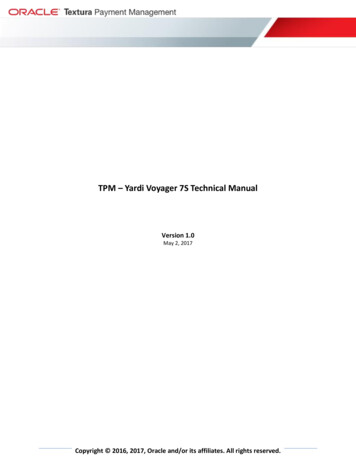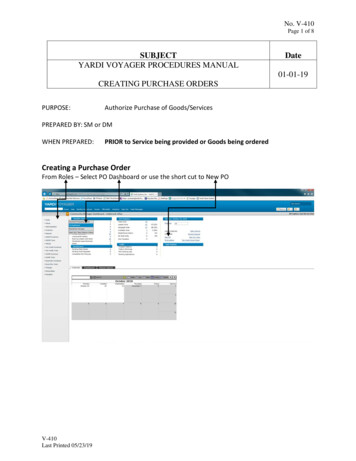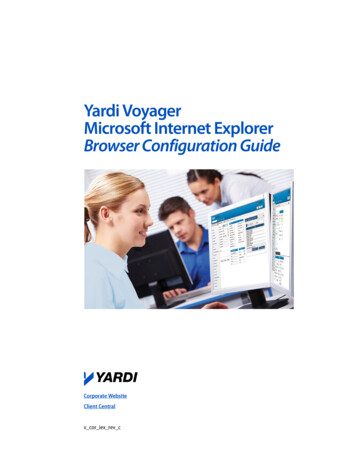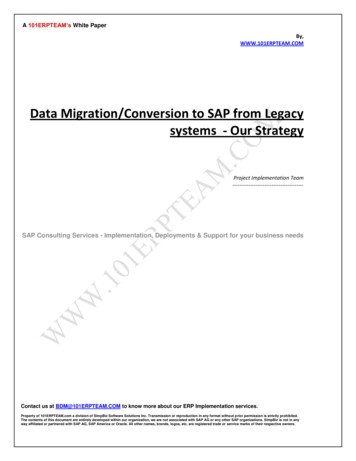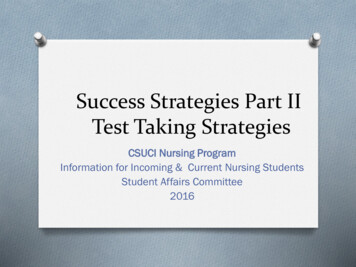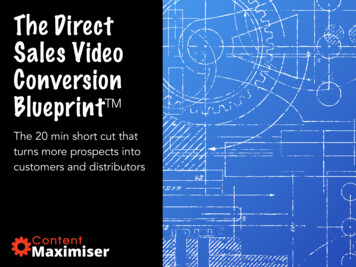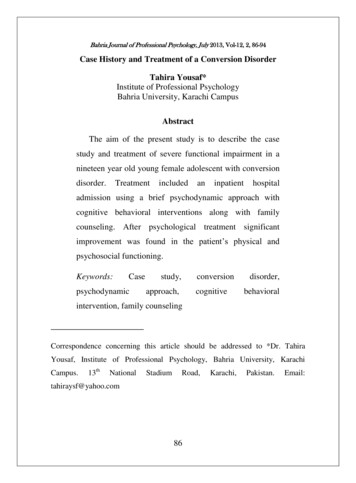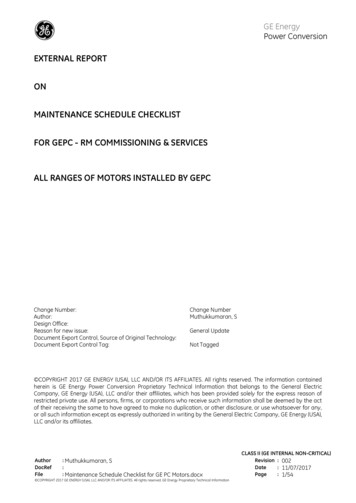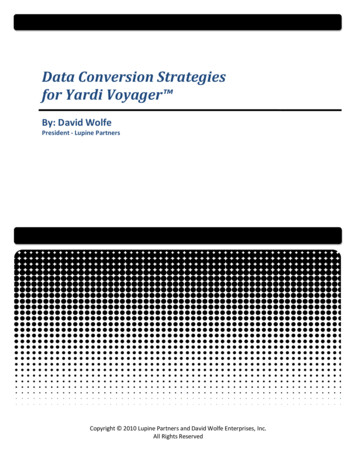
Transcription
Data Conversion Strategiesfor Yardi Voyager By: David WolfePresident - Lupine PartnersCopyright 2010 Lupine Partners and David Wolfe Enterprises, Inc.All Rights Reserved
2 Data Conversion Strategies for Yardi Voyager Is there a list of software systems that YardiVoyager can convert from?Using their ETL tool, Yardi has the ability to natively go intoseveral software packages and extract data. Generallyspeaking, Yardi can electronically convert from any system thathas the ability to produce certain source reports directly toExcel. The Excel files are an intermediate step between theinitial data extract from the source system and the import ofthe file into Yardi. Once the data has been saved as .xls file,then the user can manipulate the extract further.Manipulation examples would include tasks like formattingdates a certain way, adding constants, and deleting NULLvalues. Once the .xls file is formatted, it will be saved as a .csvfile and imported into Yardi.Do you have to betechnical to do theexports/imports?To create new ones, yes.You need to have someabilities in Transact-SQL,know the Yardi schema,and have some abilitiesand experience in usingYardi scripting. To actuallyimport the files, no. Youjust need training on howto navigate the importfunction in Yardi Admin.What is a .csv file, and why is it relevant to importing data andtransactions into Yardi?.CSV stands for comma separated value. If viewed in a text editor, such as Notepad or Wordpad,the information comes across as a string of data separated by commas. This is relevant to Yardi,because the Yardi scripting engine was originally written to only import .csv files. Although Yardiwas later updated to include .xml files as well, most companies still use .csv, because it is easy tosave and view the data in Excel.Is there an ideal time during a Yardi Voyager software implementationto convert data?It depends on the data. The conversion of GL (General Ledger) history, for example, will usuallystart at the beginning of the implementation. This is because, generally, there is between 12 and24 months of history that needs to be converted, and it can take a while to validate all of thisdata – particularly if the chart of accounts has changed between the two systems. Year-to-datevendor payments are typically converted after go-live, but before January 31 of the next year –the due date for 1099s. Variable operational data (e.g. tenant balances) will be done during the“go dark” period while end users are being trained. Static data – data that doesn’t change (e.g.units) – can be completed any time during the implementation process. However, because timegets tighter the closer you get to go-live; you will want to get this done sooner, rather than later.Copyright 2010 Lupine Partners and David Wolfe Enterprises, Inc.All Rights Reserved
3 Data Conversion Strategies for Yardi Voyager If this is a mid-year conversion, is it better to bring over year-to-datevendor payments for purposes of producing 1099s out of Yardi, or toproduce two 1099s -- one from Yardi and one from the old softwareproduct?We’ve seen this both ways. It’s easier to do two 1099s, because therearen’t any conversion ramifications. (You just print a 1099 from eachsystem.) This is fine with the IRS. Remember that 1099s are not part ofthe company’s mission - it is a reporting requirement by the IRS with a 50fine per vendor if you don’t do it. If you decide to produce the 1099s forthe entire year out of Yardi, then the best use-of-time strategy is to waituntil after the implementation is done to import and validate the data. It’snot necessary to have imported Year-to-Date vendor payments as part ofa core go-live strategy.What is data mapping – and how is the mapping best handled?First of all, it’s important to realize your old software system and Yardi Voyager store datadifferently - they are different systems. So, in order to electronically convert the data, the fieldsin the old system must be mapped to the fields in Yardi system. Most users are going to needhelp doing this, because they are familiar with the schema of the old system, but not necessarilywith Yardi’s. If you are in charge of mapping the data, it is best to work backwards from Yardi’sschema to the source system’s schema. This is due to Yardi being the ‘catcher’ of the data - thesource system being the ‘pitcher.’ Since we are migrating to Yardi, then its schema and datarules are what will dictate during the mapping process. Begin with the mandatory columns for atable in Yardi and work backwards to an equivalent column in the source database. If a columnis in Yardi but not in the source database, then this is considered a ‘gap’. Gaps can be ignored,or the relevant data can be compiled outside of the source database and entered/imported intoYardi.Is there any benefit to storing history as an attached .pdf file?Yes. The reason is that there is no validation of the tenant balance and noimporting of transaction that needs to occur. The data is actually now residingboth inside and outside of the system. It’s inside as an attachment, so you havea link to the particular object that you’re storing history for. It’s outside in thatit does not hit the Trans table; therefore, it is not technically a transaction. Onedown side to the data not hitting the Trans table is there’s no drill downavailable on this stored history; it’s just sitting there as a text object.Copyright 2010 Lupine Partners and David Wolfe Enterprises, Inc.All Rights Reserved
4 Data Conversion Strategies for Yardi Voyager How many iterations of data conversionorchestration should occur?Think of the dataorchestration processas a dress rehearsal you just might haveseveral of them beforeyou are ready for a liveperformance.You need to orchestrate the conversion of the data until it is right. Thatcould be 1 time or 20. In my experience, it usually takes 4-5 times to geteverything down correctly. Time is of the essence when you are going live,and you have to know that the routine is going to work. You don’t want tobe messing around with import scripts when the organization is down for two or three days without asystem. Think of the data orchestration process as a dress rehearsal - you just might have several ofthem before you are ready for a live performance.Is there any benefit to converting some of the tenant information earlyin the process, and then bringing in the remainder of the tenant datalater in the process?It’s an approach that has some merit. What it allows you to do is to enter or import a minimumamount of information required in order to save a tenant record in Yardi. Once a tenant recordis saved in Yardi, the system assigns a tenant ID. When tenant IDs are established, you can gowork on other areas of the data conversion that relate to a tenant. It just depends on theimplementation plan, and what you are trying to accomplish. For example, if a primary goal ofthe implementation is the have the work-order history entered early in the process, then youneed to have a tenant record established. Later on you can bring in the less importantinformation. It’s a time-saving strategy. Establishing tenant records early (even if you don’t haveall of the desired tenant information) can free you up to work on other areas of theimplementation. The down side to this approach is that you are now doing two imports.Does the ability to convert data into any Yardi tableexist?Yes. The ability does exist if you can write custom import scripts. To dothis, you need knowledge of: SQLYardi’s database schemaYardi scripting methodologyAfter you have written the custom import scripts once or twice, you willbe able to adapt that knowledge into importing into any Yardi table .Copyright 2010 Lupine Partners and David Wolfe Enterprises, Inc.All Rights Reserved
5 Data Conversion Strategies for Yardi Voyager What is the difference between staticand variable data, and how does thataffect your go-live strategy?Static data is data that, for the most part,doesn’t change. An example would be unitsin residential real estate. The tenantschange, but generally speaking, the units donot. Static data can be converted at anytimeduring the implementation process - theearlier the better, since time is at a premiumas you near the go-dark time frame.What is the difference betweenImport Trans and Import Scripts onthe Yardi menu?Import Trans is what you use to importfinancial transactions. (A financialtransaction would be a journal entry,payable, AP check, tenant charge, ortenant payment.) Import Scripts is thesystem function to import everythingbut financial transactions.Variable data is data that is unknown until you go dark (‘dark’ being that brief time period whereyou don’t have a system), and your final data conversion is occurring. An example of variabledata would be a tenant’s outstanding balance. This data cannot be converted until you closedown the old system.The variable data conversion should be orchestrated and tested for a couple of cutoff periodsprior to the go-dark/live process. You want to build a conversion protocol that gets executedduring the 1-2 days of the final variable data conversion. The orchestration process allows youto build a conversion routine that is tested for all conceivable scenarios prior to the go-livedata conversion. It is not unusual at all to encounter problems during the orchestration process.In fact, that’s why you do it to find and correct data extraction problems in a safe environmentwhere you have the time to think through all of the data issues.How much GL history should be converted?There is no right answer here, but it is a big time cost/benefitissue. In other words, is the time it takes to enter and validateall this data worth it? And, more importantly, are you actuallygoing to use this information? Clients have had their initial golive date moved back because the project moves faster thantheir ability to convert and validate the data -- validation of thegeneral ledger history taking the longest time. This can becompounded even more if you are changing your chart ofaccounts, because you are validating accounts and balanceinformation, but the GL accounts are no longer the same. Whatdo we see most often? Answer: summarized GL history for thecurrent fiscal year and one prior fiscal year, so our client canfacilitate current and prior year comparative reporting.Copyright 2010 Lupine Partners and David Wolfe Enterprises, Inc.All Rights Reserved
6 Data Conversion Strategies for Yardi Voyager Should the data in the old system be archived?Yes, it should – particularly the data that is not converted to Yardi.Sometimes, you will have access to the legacy system forever. If this isthe case, then just let the data stay there, and access it as you need it.As time goes on, you will have fewer reasons to go back to the oldsystem. If that is not the case (and, especially if you are paying licensefees on the old system), then you either need to print reports inhardcopy or save the files to use in an electronic library folder system –this way you can easily go back and find the information.Is it better to convert summarized GL transactions, each individualtransaction, or can just trial balance information be imported?There is no better or worse. The ease at which the data is pulled from the source system shoulddictate your choice. For some source systems, it may be easier to pull individual transactions.For others, the best solution would be to bring in a trial balance. It really depends on thecapabilities of the source system, its reporting capabilities, and how that data is stored in thesource system. Know that pulling individual transactions will result in a slower import processbecause of the sheer number of transactions that will be brought in. A summarized journal bymonth by property and by GL account will always go faster from an import standpoint (but thesummarized entry might be more difficult to create or ‘pull’ from the source system )Does the data conversion effort have to be done electronically or can itbe done by manually entering the data into the system?It can be done manually, and sometimes it should be. The fact of the matter is development ofthe conversion routine takes the same amount of time, whether you are converting 1 propertyor 100. Sometimes, it is faster and easier to just enter the data in by hand. There is no hard andfast rule. It somewhat depends on your abilities with data, SQL, and schema. If you are goodtechnically (or become adept at using the ETL templates), then you will probably be moreinclined to go the import route. There is a point, though, where taking the time to build dataconversion templates will save you a lot of time.Copyright 2010 Lupine Partners and David Wolfe Enterprises, Inc.All Rights Reserved
7 Data Conversion Strategies for Yardi Voyager About the AuthorDavid Wolfe, CPA is widely regarded as a leading authority on software selection andevaluation. He has been the lead consultant on numerous software selections andimplementations since he founded his software consulting firm, Lupine Partners(http://www.lupinepartners.com), in 1993. His rational and systematic approach to softwareselection and implementation has won him loyal clients across the United States. When he isnot traveling and assisting companies with their software concerns, David lives in Dallas, TXwith his wife Susan.Copyright 2010 Lupine Partners and David Wolfe Enterprises, Inc.All Rights Reserved
First of all, it’s important to realize your old software system and Yardi store data Voyager differently - they are different systems. So, in order to electronically convert the data, the fields in the old system must be mapped to
